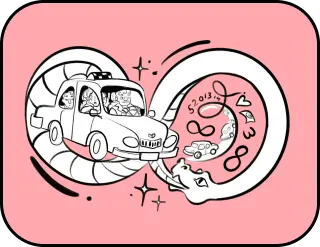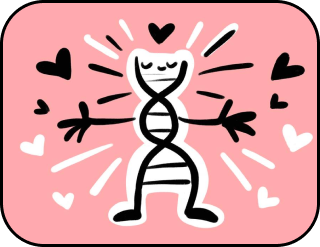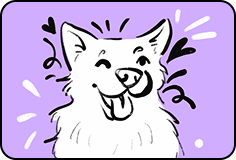Category: Materialization technologies
Orange sun: learning through color
“In Andrey’s drawing there’s a
Blue-
Blue-
Blue
Elephant.
Tell us quickly, Andrey:
Why is it blue?”
Vladimir Bredikhin, “The Blue Elephant”
Caramel sun, having just woken up, was melting into hot droplets into the creamy foam of whipped clouds.
You’re thrilled! Are you ready, holding your breath, to taste more of these dessert-like lines? A metaphorical, colorful food focus for adults that no child on the face of the earth would clap their hands for. But they should. We grow up to color someone’s childhood.
– The sun isn’t caramel. It’s inedible. Yellow like a dandelion. And only snow can melt. Got it?
Thanks for the tip, attentive reader with a lollipop.
Let’s clarify it all. We’re grabbing a palette and getting to work. Let’s paint the morning of a little life with great enthusiasm. No apron needed—children’s clothes aren’t afraid of stains. Unlike some others.
Room of Blue Tails
Children start distinguishing colors as early as their first months. Gradually, they start to recognize “sunny” colors—yellow, red, orange—and later “sky” colors—baby blue, dark blue. By age three, a young interlocutor is literally ready to “paint” any event from their vibrant life. Choosing the right “colorful” word depends on their surroundings and your joint experiences with brushes:
– Give me an apple! No, not the red one—the green one, that’s like grass. Like the one we drew under the small house yesterday. Remember?
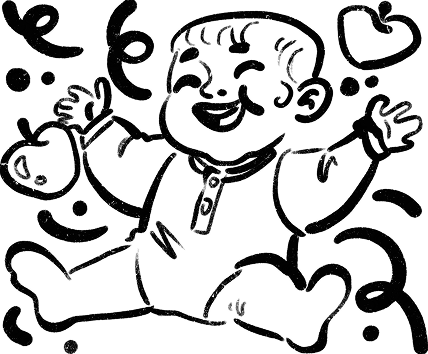
A child’s babble delights your ear while they sit on your lap. It’s a pity when an adult, who has preserved a modest childhood palette in their sensory experience, does not share that joy sincerely. You won’t be able to distinguish Monet’s water lilies from each other—vocabulary isn’t the issue here. A “color deficiency” might stem from neglecting the development of color perception in childhood—a physiological loss that cannot be recovered, as K.D. Ushinsky said: children “think in colors.” Let’s seize this moment.
Let’s draw a lime, mint, a kiwi, and an avocado.
Who keeps trying to depict a blue leaf-tail on the kiwi? By the way, that particular color is completely gone from the palette—it was used up on small joys. Don’t ignore signs from a child’s palette; they’re more helpful when choosing wallpaper for a nursery than cozy admonitions from a “yellow” astrologer about the tendencies of young Capricorns.
No myth here: girls do love pink—that’s partly true. But it’s also partly false; some love it, some don’t. Color preferences are part of the growing “Self,” which must be respected.
Color accents in play areas are good; an educational space should open a window into the world of real multicoloredness. Monochrome all around is bad—it’s better to dilute even your favorite color with harmonious splashes of another shade.
A children’s room is limited in square meters—restrictions come from your budget or circumstances beyond your control. Compensate for that! There’s no need to re-wallpaper every month and turn the nursery into a kaleidoscope. To satisfy sensory development needs, it’s enough to introduce new colors among the toys’ thickets—each new toy house-warming should be marked by comments and activities that allow adding additional shades to their worldview.

Pink Panther
Toys that won’t make you cry! If you suddenly feel “a sting” from the price of a plush panther, know this: it’s all the fault of the “pink tax.” It’s not a child’s matter to color toys based on gender. The formula “pink for girls,” “blue for boys” was invented by marketers. The first is more expensive than the second, but that’s a whole other story.
The American psychologists Vanessa Lobo and Judy Deloach removed rose-colored glasses off all those who had doubts through an experiment. Babies under two years old generally showed no interest in this color. In the “3+” category, opinions naturally divided: pink attracted girls and repelled boys. Adult gender propaganda won out. The term for this is “pinkification” (from the word “pink”). Save everyone you can!
Here’s another life raft: forget your own preferences for a moment! In the toy store, your cart shouldn’t be flashing with a trendy ivory-colored elephant. You’re not just indulging yourself, right? No blame here—we understand that, considering your inner child, marketers have placed that elephant at eye level for adults.
Choosing a color palette is an “age-related” matter. Infants learn the basics of color by noticing contrasts. One-year-olds are drawn to bright toys in primary colors. Fully understanding their “color garden” begins no earlier than one or two years old—of course, with active adult support. Only a four-year-old can confidently be handed your intricately colored elephant being involved into a conversation about shades.
Experimenting with color is fascinating, we tell you. Let’s give it a go. We present our strict little critic with a plush poodle in “White Bim Black Ear” coloring.
– What is it for? It’s like the one that Grandma has—the only difference is that it doesn’t wag its tail and its nose is dry. Let it live in the store. Buy me a plush ball instead—a white and pink unicorn, like marshmallow.
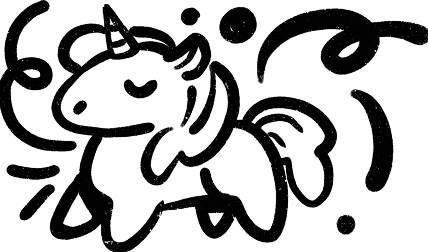
Let’s play—let’s play! Under this motto, the first five years of life fly by rapidly. A child’s game is always an experiment—more daring than ours, with boring, realistic toys. We won’t interfere.
Little Red Riding Hood with a Blue Pompom
The apple should differ from the tree—no matter how much the tree might want it otherwise.
Let’s misbehave a bit: let’s tug at the sleeve of one of today’s “beige moms.” You can easily see one on your playground: a mom dressed elegantly in “coffee with milk” shades and her child looking like crème brûlée in overalls—both from the same beige palette—a stylish wardrobe choice that looks expensive, like any timeless classic.
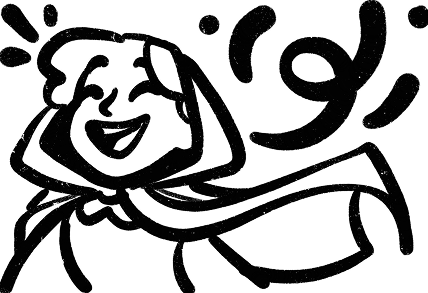
It suits you—and it suits your child too—and it blends beautifully into a cozy sandy living room interior. What’s it for? Tastes aren’t argued about— but they aren’t cloned either. Taste creates style; everyone has their own. Watching you, how you take care of yourself and follow fashion trends, your little one draws correct conclusions: that color is important—so important that it’s better to forget about the chameleon strategy of blending in under the yellow sun and instead stay like Little Red Riding Hood—visible from afar and easily recognizable—rather than being someone’s dull beige shadow-copy. By dismissing unliked colors from your child’s wardrobe with your “fashion verdict,” you risk creating gaps in their color perception.
– Sew a blue pompom onto my Little Red hat! Why? To look prettier than my teacher.
Smart daughter!
Pasta from Heaven
The “rainbow diet” was invented by adults for other adults—they put certain colored foods on the plate and promised more nutrients would enter the body. Whether it works or not is uncertain; that’s how the third type of adults think-they are scientists who haven’t yet found a direct link between the food spectrum and improved overall health of this “colorful” gourmet.
But there are small exceptions to these rules—literally small ones:
– I want blue shells that fell from the sky. And you’re already grown-up—you can only have boring white pasta.
Their whole life is play! Colorful food is strictly allowed; favorite colors spark imagination and bring joy. When emotionally high, children show natural curiosity about shape and color, which also stimulates their interest in food—that’s exactly what we’ve been trying to achieve.

Blue Beard and Blue Hair
If you were to wind the red threads of our “bedtime stories” into a single ball, you would get a colorful yarn. A metaphorical trick that even a child can understand. The names of characters, details of the fairy tale universe—everything is painted in color. Walk past—and you won’t understand anything.
Let’s pause. Observe how, for a young reader, color shifts from being a feature of recognition to a feature of awareness.
For children under six, the Blue Fairy visually differs from other girls by her hair color. Simple and clear. For an adult philosopher, Blue Beard is like the blue elephant from the epigraph. Additional explanations are needed.
In a nutshell, we want to talk about this.
Color is a cultural code, born from the collective unconscious. Specifically, as the psychoanalyst Carl Jung explained to us clearly, blue is high and deep — like the sky and the ocean. An intellectual color for those inclined to think and dream.
– Let me explain it to you! You have to do everything carefully. Don’t touch the fence if it’s just been painted! He’s stained his beard with paint. Let it stay dirty! He’s so scary.

Indeed, Charles Perrault’s story turned out quite creepy. You can turn blue from fear. The associative thinking speaks through the voice of a child: blue = scary.
I wonder what Carl Jung would have said about this? He probably would have blushed with pleasure. The hypothesis is workable: Jung truly believed that there can be no universal interpretation of color. Besides cultural context, personal history—including childhood experiences—influences how we perceive blue hair and blue beards. Of course, attitudes toward color can change with age. But as long as the brush is in your hands, direct it in the right direction—creating positive, colorful associations in a bright child’s mind.
“Colorful” reading is more than just voicing the text. The entire fairy-tale palette should come through during discussions of what’s been read. Let’s take off the key to the secrets of our adult world from around our necks—where all colors are “speaking.” In the language of symbols.
– Not just a key, but a tiny golden key!
Exactly. Only with such a key can most doors be opened—behind which goldfish fulfill our most cherished wishes. You’ll understand it when you grow up— which means maybe even tomorrow.
And finally, we will sing (thanks to the Blue Tractor for the inspiration):
But first, let’s set up an experiment in magazine conditions. Let’s discard the words from Yuri Entin’s popular children’s summer song:
On a green sunlit clearingGreen frogs are jumping
And butterfly friends are dancing,
Everything around is blooming.
A dry lyric without colorful imagery doesn’t evoke the usual emotional response:
– I don’t want your music! Play my song!

The little listener feels disoriented. To truly sympathize with frogs, you need to know everything about them—including their coloring. Otherwise, full acquaintance won’t happen. Moreover, melodic colorful spots are a source of joy for children. Our love for “painting” in songs stays with us throughout life. Nostalgic for childhood, like “Zemlyane” with the poet Anatoly Poperichny:
And we dream of grass, grass near our house,
Green, green grass.
When you see a melting caramel sun—that’s a sign that your childhood has gone away; to where yellow sunshine plays across the blue sky. Now you are an Artist—with a capital A—because this morning you’re going to paint not only for yourself but also for others—fellow artists starting out on this journey of life. Here’s our gift: a brush for you!
The Einstein-Rosen bridge? We’re building it out of facts.
Thank you!


